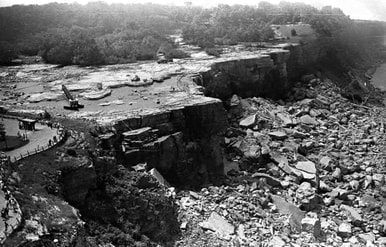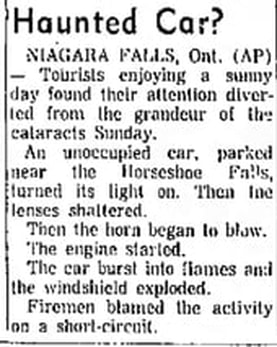 By M.P. Pellicer | Stranger Than Fiction Stories Niagara Falls has been a favorite destination for honeymooners for decades. Like a magnet, it also draws daredevils and those wishing to release themselves from this mortal coil.  Father Hennepin at Niagara Falls c.1678 Father Hennepin at Niagara Falls c.1678 Niagara Falls is made up of three waterfalls that are 18,000 years old. Two in the United States and one in Canada. Horseshoe Falls spans the border of both countries, and empties into the Niagara River; it's the largest of the three. The falls have a vertical drop of more than 165 feet. At the turn of the 17th century Samuel de Champlain, a French explorer heard of the awe inspiring waterfall, but it was not until 1678 that Father Louis Hennepin saw them first hand. With the advent of the railroad, Niagara Falls became a tourist destination and a favored honeymoon spot. Since 1846, the sightseeing boats that tour the Falls have been named the Maid of the Mist, based on an Iroquois myth. In 1895, the first hydroelectric generator was switched on, but it was Nikola Tesla who helped divert power to Buffalo, New York, and present day it produces 2.4 million kilowatts of power through hydroelectricity.  Niagara Falls temporarily drained c.1969 Niagara Falls temporarily drained c.1969 In 1969, due to instability the fall in America was drained. This was done in order to allow geologists to examine a rock pile at the bottom. Many expected secrets to be uncovered in the endeavor, especially the most gruesome of all, which were the bodies of those that had gone over the falls, but had never been recovered. At that time there was an average of 25 suicides per year. Police discovered the remains of a man, a woman and the carcass of a deer amongst the rocks of the talus at the base of the Falls. The man was not a mystery, and he had not been there long. There was a sighting of a man jumping into the channel above American Falls on June 11 the day before the water was stopped. Some who saw him thought he was a worker. The man had walked along the shore, until he reached the brink and jumped in from Prospect Point. The body fit the description of the man who was seen wearing a green plaid shirt and pants. He was in his 20s, and has never been identified. The woman was decomposed and wedged between rocks head first. She wore a red and white horizontal striped dress. A gold wedding band was inscribed inside: "Forget Me Not". Like the man, she has never been identified. Two months later in August, 1969, a man's dismembered body parts were found around the Ontario Hydro Forebay. Pieces of him came floating in for about one week. He was estimated to have been in his 50s to 60s. He was white, had gray or white hair with brown eyes. He had no dental work done, but his teeth were dirty and full of cavities. He had only one tooth in his upper jaw, and a few were missing from his lower jaw. The cause of death was thought to be homicide, and his identity has never been established.  Deaths at Niagara Falls are attributable to murder, suicide and accident. Deaths at Niagara Falls are attributable to murder, suicide and accident. It's inevitable that there are ghost stories about Niagara Falls. The most obvious sources are those that have died at the Falls through suicide or even murder. There is a Hat Man who has been seen wearing a tall hat and missing a leg from the knee down. He just disappears when approached. Another story involves one Trevor McMyler was 16 years old when he visited Niagara Falls with his mother and sister. He was angry and believed his mother favored his 6-year-old sister Annabelle. Their father had abandoned the family three years before. After visiting the falls they were on the Number 7 trolley, which rides over Horseshoe Falls. Only two seats were available and his mother insisted he stand so his sister could sit in one. An argument started, and Trevor would go on to jump over the falls that very day and is said to haunt Trolley Number 7. There is no record of this event, and it sounds childish and made up, but that doesn't mean other haunting events have not taken place there. In 1874, the body of a painter named Vedder of Drummondville, Ontario was found in the whirlpool at Niagara. He had disappeared two weeks before. He wanted to marry the daughter of one Mrs. Upper who didn't approve of the match. She hired three men to beat him, and he lodged a complaint with the Mayor of Clifton. They lured him with the pretense of getting him a job on Navy Island, and it's believed they threw him in the river above the falls. The "ruffians" were named McSevel, Fannigan and Cross, who suddenly left the neighborhood. In 1895, on the other side of the border in Niagara, Ontario, Frank Rogers disguised himself as a ghost and planned on playing a practical joke on his Italian neighbor, who was so scared that he threw a pitchfork at Rogers, hitting him in the eye, penetrating the brain and killing him. In 1897, a story circulated that a woman with long flowing hair walked out from the rapids near where Elizabeth McRoberts, 66, committed suicide a month before. She would stroll about the Reservation on moonlit nights and then return to the water. When the body of Elizabeth McRoberts was recovered, another badly decomposed body of a man was taken out of the whirlpool. It was thought to be the corpse of Mr. Webber who along with two companions went over the falls in a rowboat.  Captain Matthew Webb died while trying to swim under the Niagara Falls Captain Matthew Webb died while trying to swim under the Niagara Falls The Falls would claim even those that overcame other dangerous places. Such was the case of Captain Matthew Webb, who in 1875 was the first person to swim the English Channel in 22 hours. He had already received attention before this event. He joined the merchant navy when he was a teenager and served on the Cunard Line ship Russia. He dove into the mid-Atlantic to rescue a man who went overboard. The man was not found, but Webb was awarded £100 and the first Stanhope Medal. The British press hailed him a hero. In 1863, he rescued his brother Thomas, 12, who almost drowned in the Severn near Ironbridge. Within ten years he was already a captain on his own ship. After he successfully swam the English Channel he participated in different races and his celebrity increased. His final stunt was to swim in the Niagara Gorge through the Whirlpool Rapids, which is below Niagara Falls. Many considered this feat to be suicidal. On July 24, 1883, he jumped into the river from a boat stationed near the Niagara Falls Suspension Bridge. He started to swim and was doing well, until he reached the section of the river located near the entrance to the whirlpool where he drowned. He was buried in Oakwood Cemetery in Niagara Falls. He was 35 years old.  In 1920, a ghost was terrorizing the area of Niagara Falls, the residents thought it was the ghost of a woman murdered by her husband. In 1920, a ghost was terrorizing the area of Niagara Falls, the residents thought it was the ghost of a woman murdered by her husband. In 1920, there were sightings of a ghost dressed in white and said to have long streaming hair. Police followed the ghost and saw it enter a cornfield, which they surrounded and searched without finding the apparition. The police thought it was someone playing a joke, the residents believed it to be the ghost of Mrs. Rountain who was murdered by her husband 2 years before. The Read Coach Inn is supposed to be haunted as a result of when a husband killed his bride in December, 1927. He bludgeoned her to death in their bedroom. Guests describe temperature changes and doors opening, also voices and a woman screaming.  There is no record of this event, which probably puts it into the category of urban myth, however there could be other sources for the story. In September 1927, Jennie Cohen, a bride of only four days died in an automobile accident. She was riding with her husband over the "Honeymoon Trail" bound for Niagara Falls. The touring car rolled over twice and hit a tree. The husband was not injured. Another story involved the death of a bride after honeymooning at Niagara. This happened in September 1929. Mary Lewis, 26, was riding with her husband on the Honeymoon Trail when their car crashed into a cement abutment and overturned. She died on the way to the hospital, and her husband was only slightly injured.  In January 1935, police were sent out for a report of a nude man running about in Oakdale Cemetery on Portage Road in Niagara Falls. This was the same cemetery where the unfortunate Captain Webb was buried in 1883. A young woman coming home from work at 9:30 p.m. saw him, and she told firemen at the Tenth Street fire hall that was a block away. The naked man had whistled at her. The police found no one, so they took her home, and the incident was chalked up to the man being a ghost. Perhaps it wasn't a naked man, but one just wearing a bathing suit. In 1959, a stranger walked into a restaurant and asked the owner Vincent Davolio to change a $100 bill into U.S. currency. Davolio assumed it was Canadian money, but later when he took a look at the bill, it bore the inscription, "Confederate States of America" and dated November 20, 1862. The man had already left. From then on, he was referred to as the Gray Ghost. In April 1972, an unoccupied car parked near the Horseshoe Falls had its lights turn on, then the lenses shattered. The horn began to blow, the engine started, then the windshield exploded when the car burst into flames. The firemen blamed it on a short circuit.  The rescue from the Niagara Scow c.1918 The rescue from the Niagara Scow c.1918 For the stories of those whose luck ran out at Niagara Falls, there are those who did escape a tragic end. In August, 1918, Gustave Lofberg and Frank Harris were dredging up a sand bank from the Niagara River, upstream from the waterfall on the Niagara Scow. When a tugboat came to bring the scow back to shore it broke loose, and floated downriver heading straight for the falls. They dropped the Scow’s 6-ton anchor, but the chain broke. Then they dumped their load of sand, and the boat got caught on a rock shoal only 838 yards from the edge of the falls. Since they were so close to the edge, sending a boat to rescue the two men was out of the question. The U.S. Coast Guard sent a lifeline, using a cannon line over to the boat from the roof of the Toronto Power Plant. After 17 hours, the two men made it back to shore using a breeches buoy. The wreck of the Old Scow as she was also known deteriorated over the years, and in 2019 record high water levels allowed the iron barge to drift another 50 yards downriver. In 2022, it broke into several pieces that lodged in the rapids. A similar wreck, the Sunbeam was caught in the shoal close to the Niagara Scow in 1923. It was once a WWI antisubmarine patrol boat. Abandoned it broke apart during the years, and the boilers and propeller shaft are seen when water is diverted for hydropower production. Present day, Niagara Falls despite the beauty of the landscape has a serious problem with crime. There is a high poverty rate which has produced a significant number of violent crimes. Caution is advised when visiting the city.
0 Comments
Your comment will be posted after it is approved.
Leave a Reply. |
Stranger Than Fiction StoriesM.P. PellicerAuthor, Narrator and Producer Archives
July 2024
Categories
All
|
Stories of the Supernatural
- Stories of the Supernatural
- Miami Ghost Chronicles
- M.P. Pellicer | Author
- Stranger Than Fiction Stories
- Eerie News
- Supernatural Storytime
-
Astrology Today
- Tarot
- Horoscope
- Zodiac
-
Haunted Places
- Animal Hauntings
- Belleview Biltmore Hotel
- Bobby Mackey's Honky Tonk
- Brookdale Lodge
- Chacachacare Island
- Coral Castle
- Drayton Hall Plantation
- Jonathan Dickinson State Park
- Kreischer Mansion
- Miami Biltmore Hotel
- Miami Forgotten Properties
- Myrtles Plantation
- Pinewood Cemetery
- Rolling Hills Asylum
- St. Ann's Retreat
- Stranahan Cromartie House
- The Devil Tree
- Trans-Allegheny Lunatic Asylum
- West Virginia Penitentiary
- Paranormal Podcasts
"When misguided public opinion honors what is despicable and despises what is honorable, punishes virtue and rewards vice, encourages what is harmful and discourages what is useful, applauds falsehood and smothers truth under indifference or insult, a nation turns its back on progress and can be restored only by the terrible lessons of catastrophe."
- Frederic Bastiat
- Frederic Bastiat

Copyright © 2009-2024 Eleventh Hour LLC. All Rights Reserved ®
DISCLAIMER
DISCLAIMER

 RSS Feed
RSS Feed
















